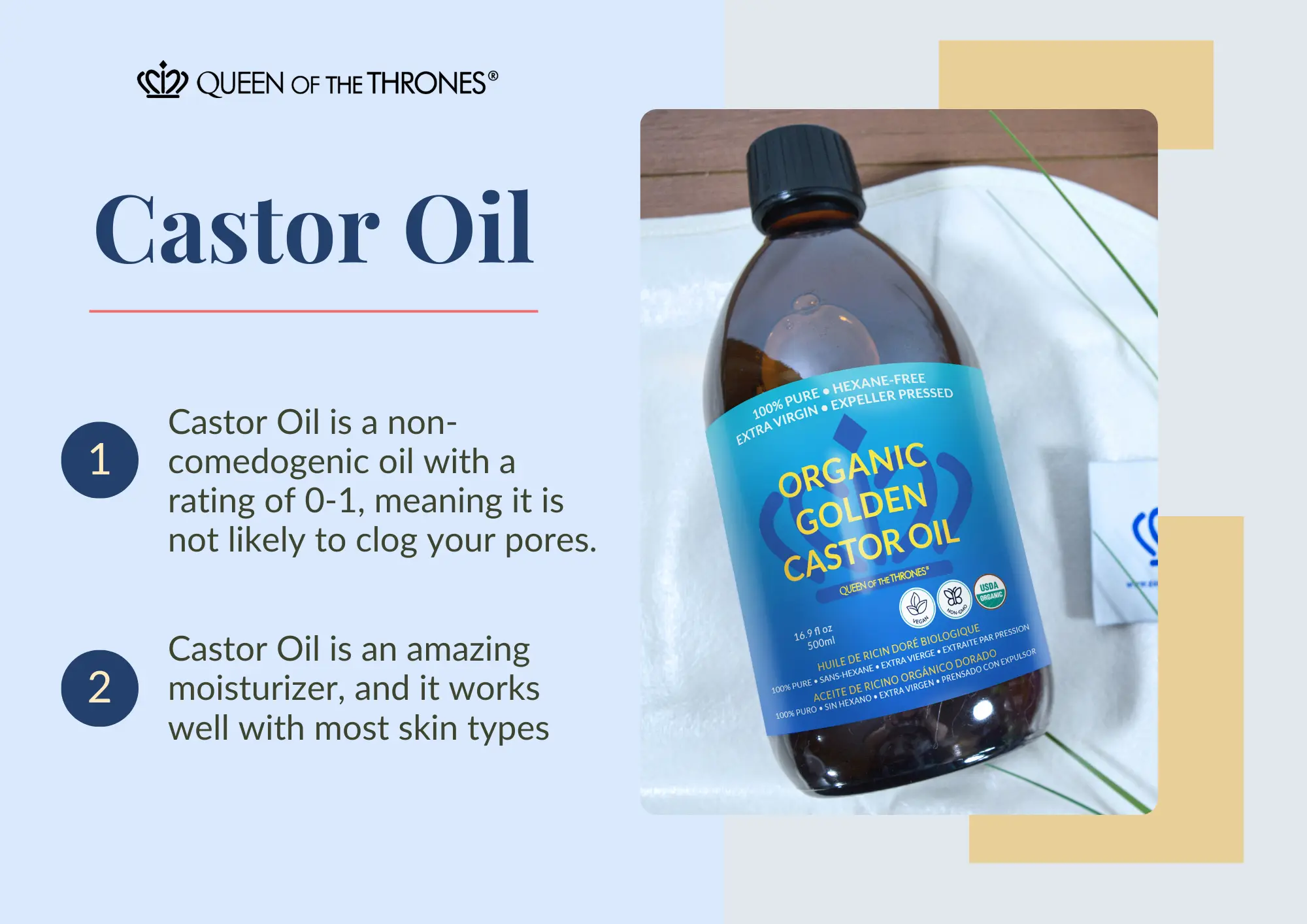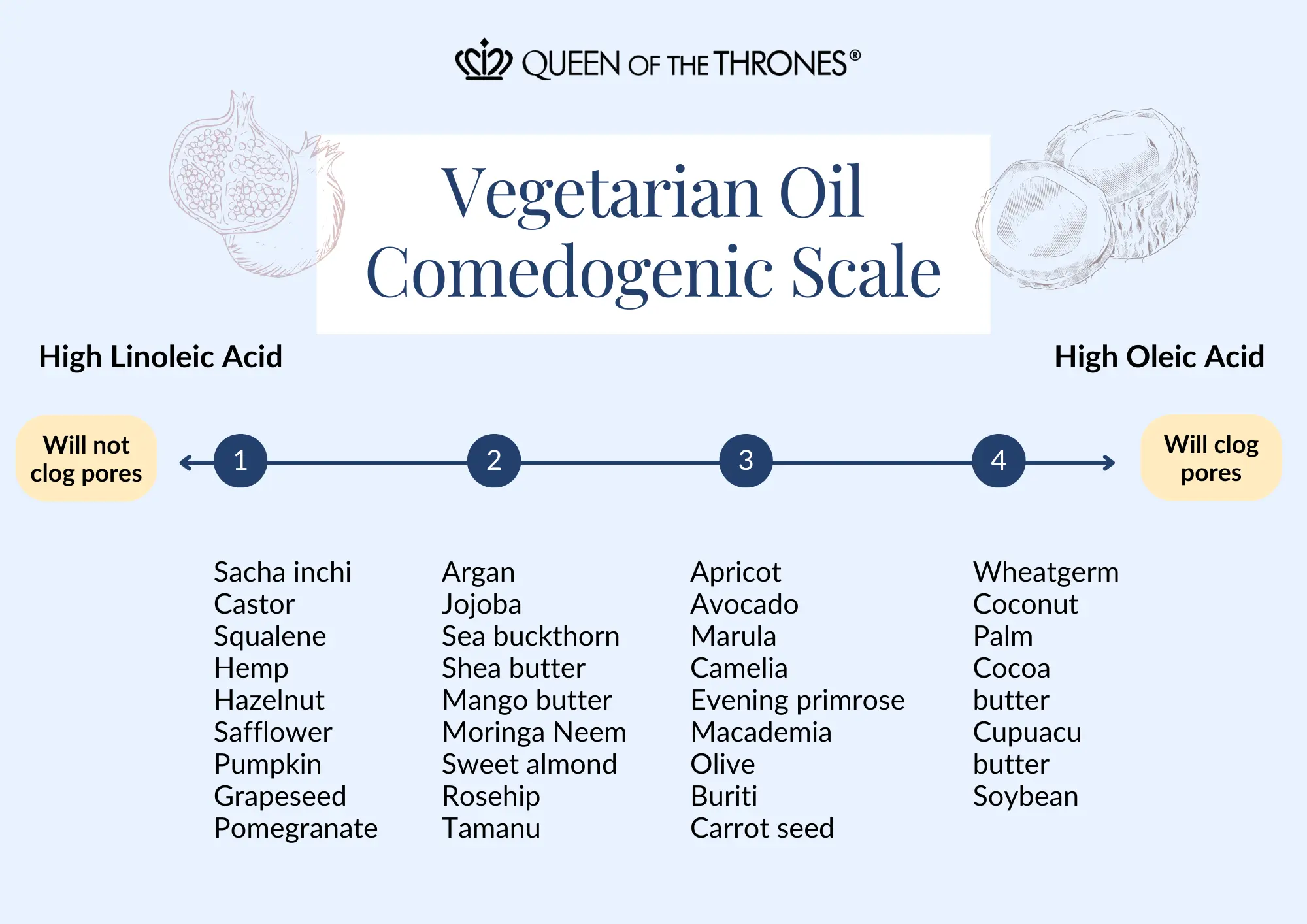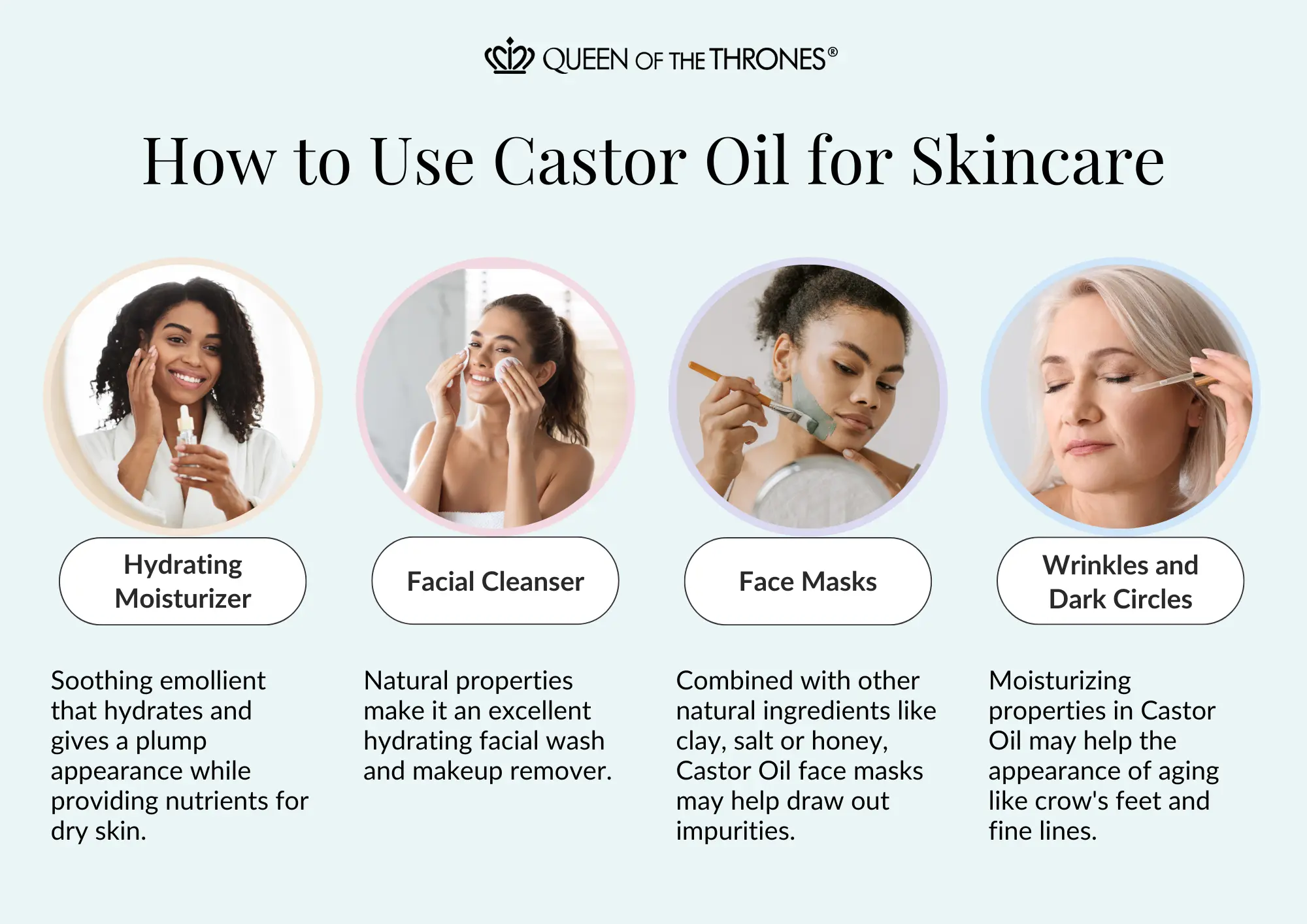
Is Castor Oil Comedogenic and Will it Clog My Pores?
Written by: Joanna Teljeur B.A.
Medically reviewed by: Victoria Williams R.H.N.
Est. reading time: 7 minutes
Thick and luscious, Castor Oil feels glorious on your skin, especially when you smooth it on your face before bed. It’s rich texture alone makes you feel like your skin will plump up beautifully overnight.
Maybe you’ve felt like slathering this golden oil filled with skin-loving fatty acids onto your face, letting the vitamins and nutrients do their handiwork.
But then, you might have stopped suddenly and thought: “Wait a minute! Castor Oil is so thick and rich, will it clog my pores?”
Is this you?
If you’re worried that Castor Oil could clog your pores, you’re not alone. There’s been plenty of confusion and debate about whether Castor Oil can clog pores or cause breakouts. But rest easy, because in this blog, we’ll explore the comedogenicity of Castor Oil, and delve into the reasons why it has been heralded as an amazing skin elixir, thanks to its rich composition of vitamins and fatty acids.

Key Points:
- Castor Oil is a non-comedogenic oil with a rating of 0-1, meaning it is not likely to clog your pores.
- Castor Oil is an amazing moisturizer, and it is safe for most skin types.
- Castor Oil is a non-comedogenic oil with a rating of 0-1, meaning it is not likely to clog your pores.
Will Castor Oil clog my pores?
What does comedogenic mean?
Comedogenicity refers to the ability of a substance, typically found in skincare and cosmetic products, to clog pores and potentially cause comedones. Comedones are non-inflammatory acne lesions more commonly known as pimples!
Yes, we’re talking about those all-too-familiar blackheads and whiteheads that show themselves when your hair follicles become blocked by excess oil, dead skin cells, and other debris. So, if something is non-comedogenic, it means that it will not contribute to clogged pores and breakouts. Castor Oil is non-comedogenic.
What makes a substance comedogenic?
A substance is comedogenic if it blocks pores and results in comedones – AKA pimples. It’s important to remember that individual ingredients can be non-comedogenic but may become comedogenic when mixed with other substances. For example, Castor Oil is non-comedogenic, but if you mix it with beeswax or red dye (as many cosmetics do), then the mixture can be pore-clogging.
What is the comedogenic scale?
The comedogenic scale is a rating from 0 to 5. Simply put, if a substance has a rating of 0 it is considered non-comedogenic, meaning that it is less likely to clog your pores. Substances with higher ratings are more likely to cause clogged pores and lead to pimples, breakouts and whatever else you choose to call those dreaded lesions.
But again, if you love Castor Oil, you’re in luck because it has a very low comedogenic rating. So chances are, you can use it as a makeup remover and moisturizer and know that it will not contribute to breakouts!

Understanding the comedogenicity of skincare and cosmetic products is especially important if you’re prone to breakouts or if you have sensitive skin. So, if this is you, be sure to look for non-comedogenic products that will minimize the risk of pore clogging, like organic Castor Oil.
Is Castor Oil good for skin
So, now you know that despite the thick and viscous nature of Castor Oil, it has a very low comedogenic rating. But you might be thinking, How can a rich, thick oil like Castor Oil NOT clog my pores?
Castor Oil is an ancient, versatile, and beloved vegetable oil that has been used for centuries for its numerous self-care and beauty benefits, and one of its most popular applications is in skincare.
While it might be extra thick and even sticky, Castor Oil may help moisturize and hydrate skin, while supporting the appearance of fine lines and wrinkles. Amazing, agreed?
But let’s take a closer look at the main components of Castor Oil and what makes it so well suited for skincare.

- Ricinoleic acid
Castor Oil is rich in ricinoleic acid, and by rich, we’re talking like 85-92% of the total fatty acid3 content.
When you apply it to your skin, ricinoleic acid may help support skin irritation, the appearance of redness, and may even create a calming sensation on skin, making it an excellent choice if you are experiencing any of these struggles.
- Vitamin E
Castor oil contains a significant amount of vitamin E,5 which helps in maintaining skin wellness and may even support signs of premature aging, while potentially supporting the appearance of scars and blemishes.
- Omega Fatty Acids
Castor Oil contains essential omega fatty acids, such as omega-6 and omega-9. These fatty acids are vital for maintaining the skin’s moisture barrier, keeping it hydrated and nourished. Castor Oil also contains other fatty acids including linoleic, oleic, stearic, palmitic, dihydroxystearic acid, linolenic acid, and eicosanoic acid6.
- Polyphenols
Polyphenols are a group of natural compounds found in various plant-based foods, including fruits, vegetables, herbs, spices, tea, dark chocolate, and wine.
Polyphenols are believed to support clearer, more radiant skin.
Who should use Castor Oil for skincare?
Castor Oil works beautifully as part of a general skincare routine. If you have mature or very dry skin, then you’ll especially love its moisturizing qualities.
If your skin is oily, then you might only want to use Castor Oil on your face a couple of times a week, because while Castor Oil is non-comedogenic and won’t clog pores, it is an oil. We’re all biochemically unique, so try it on a small area of your skin first to see how it feels.
If you have frequent breakouts, then Castor Oil may help support your skin by working as a natural cleanser.
Again, you may want to try it on a small area of your skin first to be sure if Castor Oil is right for you.
How to use Castor Oil for skincare
Are you ready to add Castor Oil to your skincare routine? Interestingly, you might be using Castor Oil already without even realizing it. You see, Castor Oil has been used as an ingredient in cosmetics, shampoos, soaps, bath oils, and countless other products for many years!
But if you want to add this luscious oil to your skin in its pure form, then stick to brands that are 100% pure, organic, hexane-free, cold or expeller pressed, and bottled in amber glass.
Why? Because the quality of the oil contributes to its comedogenicity. Basically, if a substance is impure, it could clog your pores.
Queen of the Thrones® Organic Golden Castor Oil is ideal for direct use on your skin and especially on your delicate facial skin because it is:
- 100% pure
- Certified organic
- Extra virgin
- Hexane-free
- Bottled in amber glass
Better still, Queen of the Thrones® Organic Golden Castor Oil is sourced by a naturopathic doctor and recommended by thousands of functional medicine practitioners, chiropractors, osteopaths, mental health doctors, health coaches, and wellness influencers who all include it as a foundational part of their practice.
Castor Oil can be added to your skincare routine in a number of ways:
- As a moisturizer: The fatty acids may help retain moisture, giving your skin that plump look we all love. It’s especially helpful if your skin is overly dry as it may help give your skin the nutrients it craves. And if you already have well balanced skin, then Castor Oil may help support this balance.
- A facial cleanser: Castor Oil has naturally occurring properties that make it ideal as a gentle cleanser and make-up remover.

- As part of a face mask: The natural properties in Castor Oil help dissolve impurities on your skin like make-up residue, while adding moisture and a protective barrier to help your skin stay hydrated.
- Around your eyes for fine lines and wrinkles: Because Castor Oil is so rich and thick, it works especially well around your eyes to help support the appearance of fine lines and wrinkles. To maximize the benefits, you can wear an Castor Oil Beauty Mask to bed at night. Wearing an eye mask to bed may even help support a more restful sleep while adding moisture to the delicate skin around your eyes.
Castor Oil is an amazing moisturizer it may even help promote a more even skin tone. In rare cases, a hypersensitivity reaction may occur, in which case you should discontinue use.
If you’d love a little inspiration, you could start by trying this amazing recipe:
Castor Oil Golden Mask: A Face Mask to Support Clear Skin
Prep time: 5 minutes
Ingredients:
- 2 teaspoons of Queen of the Thrones® Organic Golden Castor Oil
- 1 egg yolk: Provides zinc to soothe and Vitamin A for dry skin
- 1 tablespoon of raw honey: Honey has natural antibacterial properties which may help keep pimples at bay.
Directions:
- Mix ingredients until it is smooth and spreadable.
- Apply the mixture to your face (avoiding your eyes), and leave it on for 15-30 minutes.
- Using a warm washcloth, remove the mask until no residue is left.
- Follow with your favorite moisturizer, or apply Castor Oil to target areas like wrinkles, frown lines, eyelashes, and eyebrows before bed.
- You can also deepen this practice by wearing the Castor Oil Beauty Mask while you sleep.
So there you have it. Castor Oil is generally non-comedogenic and unlikely to block pores for most people. Its unique composition, including ricinoleic acid, vitamin E, omega fatty acids, and polyphenols, makes it a valuable addition to your skincare routine.
Would you love to partner with Queen of the Thrones®? Apply to become an Affiliate or Wholesale Partner now!
Click here for references
1. Final report on the safety assessment of Ricinus Communis (Castor) Seed Oil, Hydrogenated Castor Oil, Glyceryl Ricinoleate, Glyceryl Ricinoleate SE, Ricinoleic Acid, Potassium Ricinoleate, Sodium Ricinoleate, Zinc Ricinoleate, Cetyl Ricinoleate, Ethyl Ricinoleate, Glycol Ricinoleate, Isopropyl Ricinoleate, Methyl Ricinoleate, and Octyldodecyl Ricinoleate. Int J Toxicol. 2007;26 Suppl 3:31-77. doi: 10.1080/10915810701663150. PMID: 18080873.
3. Omari, A., Mgani, Q.A. and Mubofu, E.B. (2015) Fatty Acid Profile and Physico-Chemical Parameters of Castor Oils in Tanzania. Green and Sustainable Chemistry, 5, 154-163.
5. Iqbal J, Zaib S, Farooq U, Khan A, Bibi I, Suleman S. Antioxidant, Antimicrobial, and Free Radical Scavenging Potential of Aerial Parts of Periploca aphylla and Ricinus communis. ISRN Pharmacol. 2012;2012:563267. doi: 10.5402/2012/563267. Epub 2012 Jul 11. PMID: 22919511; PMCID: PMC3418662.
6. Omari, A., Mgani, Q.A. and Mubofu, E.B. (2015) Fatty Acid Profile and Physico-Chemical Parameters of Castor Oils in Tanzania. Green and Sustainable Chemistry, 5, 154-163.


0 Comments